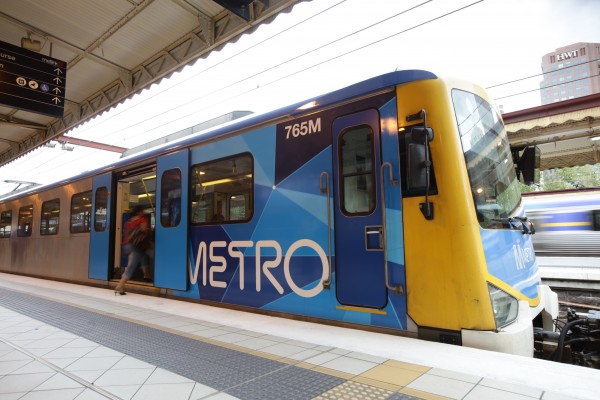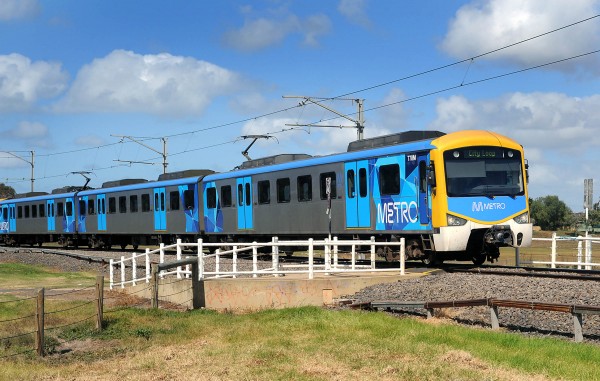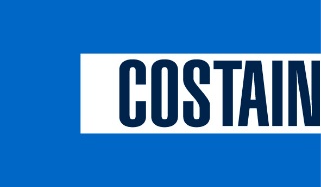Improving Melbourne’s metropolitan train system one step at a time
Posted: 3 August 2010 | | No comments yet
Six months in to its contract as operator of Melbourne’s metropolitan train network, Metro’s focus is firmly on improving asset reliability, simplifying the timetable and making every minute count.
In 2009, the Victorian Government selected a new contractor to operate Melbourne’s metropolitan rail services. The network assets, which are Government-owned and funded, have been privately operated and maintained since 1999.
On 30 November 2009, Metro Trains Melbourne (Metro) began operations, taking over from former operator Connex (Connex was involved in the management of Melbourne’s rail network since it was privatised, and assumed full operational control of the network in 2000).
Six months in to its contract as operator of Melbourne’s metropolitan train network, Metro’s focus is firmly on improving asset reliability, simplifying the timetable and making every minute count. In 2009, the Victorian Government selected a new contractor to operate Melbourne’s metropolitan rail services. The network assets, which are Government-owned and funded, have been privately operated and maintained since 1999. On 30 November 2009, Metro Trains Melbourne (Metro) began operations, taking over from former operator Connex (Connex was involved in the management of Melbourne’s rail network since it was privatised, and assumed full operational control of the network in 2000).
Six months in to its contract as operator of Melbourne’s metropolitan train network, Metro’s focus is firmly on improving asset reliability, simplifying the timetable and making every minute count.
In 2009, the Victorian Government selected a new contractor to operate Melbourne’s metropolitan rail services. The network assets, which are Government-owned and funded, have been privately operated and maintained since 1999.
On 30 November 2009, Metro Trains Melbourne (Metro) began operations, taking over from former operator Connex (Connex was involved in the management of Melbourne’s rail network since it was privatised, and assumed full operational control of the network in 2000).
Who is Metro?
Metro is a joint venture owned by three leading rail industry businesses: Hong Kong’s MTR Corporation, Australia’s John Holland Group and UGL Rail. MTR is recognised as one of the world’s leading railways for safety, efficiency, reliability and customer service, moving approximately 3.7 million customers daily with an on-time reliability record of over 99%. The John Holland Group operates Australia’s largest privately owned rail maintenance and construction plant and equipment fleet, and has successfully carried out major works on Melbourne’s existing rail network. UGL Rail, a division of Australia’s United Group Limited, is a leading supplier to the rail sector providing complete rail solutions that include asset management and maintenance of rail networks, infrastructure and rolling stock design, engineering, manufacture and refurbishment.
The joint venture is a fully integrated business model with operations, maintenance and renewals, and projects under one roof with clear lines of accountability.
At the time of the appointment, Victorian Premier John Brumby said the consortium’s offer represented the best value for taxpayers. “Most importantly, Metro Trains Melbourne made it clear that its priority is to focus on what we believe are non-negotiables for Melbourne commuters: punctuality, safety, reliability, customer service and cleanliness”, he said.
The network
Melbourne’s network is the one of the most extensive above-ground metropolitan rail networks in the world with 830km of track on 15 lines servicing 211 stations, with one more new station that opens in June 2010. The fleet of more than 150 six-carriage trains comprises a mix of X’Trapolis, Siemens, Comeng and Hitachi trains. Our fleet covers more than 30 million kilometres each year and services more than 200 million customer journeys.
A challenging operating environment
Melbourne’s suburban rail network operates in a challenging environment with significant pressure on its public transport system. The city has a population of more than 4 million, and this population is increasing rapidly. Melbourne’s population is now growing faster than any other Australian city and it’s expected to increase by another million by 2025. This means huge challenges and great opportunities for us.
Melbourne’s train patronage is also booming, having grown by more than 50% since 2004. This is due in part to the population increase, but also to a growing preference for public transport over other modes of transport. Melbourne’s network currently services nearly 400,000 customers each work day. We expect this upward trend to continue; it is predicted that patronage will double by 2020. We are currently working towards increasing the capacity of the network to handle this.
The configuration of the network presents its own challenges. The 15 lines radiate from the central City Loop, placing increased importance on cross-city connections and intermodality with Melbourne’s bus and tram networks. Metro’s shared fare box with Melbourne’s other public transport operators adds further incentive for developing effective integration between the three public transport modes.
Measuring and improving performance
When we took over operation of the network last November, we announced our intention to deliver improved reliability and punctuality by moving Melbourne’s train system towards a metro-style operation that better meets the city’s growing public transport needs.
The Victorian Government has applied a tougher measurement system under Metro’s contract for both delivery and punctuality. For example, under the previous contract, a train that bypassed Melbourne’s City Loop, or didn’t reach its final destination, was counted as a full service. Under the new contract with Metro, it now contributes to the cancellation rate. The definition of an ‘on-time’ train is also different. The previous threshold of 5 minutes and 59 seconds has been reduced to 4 minutes and 59 seconds.
Our contract specifies that not more than 2% of trains can be cancelled and not more than 12% of trains can run late in a month, otherwise compensation and penalties are triggered.
Our long-term objective is to deliver a clock-face timetable with consistent stopping patterns and evenly spaced services, so that more people can be transported more often with fewer cancellations and less delays.
We have identified three key priorities that we believe are critical to delivering this objective:
1. Improving the reliability of the network’s assets
2. Simplifying the timetable
3. Adopting an organisation-wide focus on customer service with an ‘every minute counts’ philosophy.
It is now just over six months since Metro took over operations, and by focusing on these three priorities we’ve already implemented a significant number of changes aimed at improving reliability and punctuality, as detailed below.


A new look for Melbourne’s fleet
Improving the reliability of the assets
One of our key strategies is to transform Melbourne’s train network through maintenance, repairs and upgrades. Our initial focus has been on introducing a proactive, preventative approach to infrastructure and rolling stock maintenance.
Coinciding with Metro’s commitment in this area, the Victorian Government has provided a 60% increase in funding for rail infrastructure. To optimise this investment and ensure it translates into performance improvements, we have developed a comprehensive schedule of maintenance and upgrade works.
We are currently undertaking a maintenance blitz in a concentrated effort to lay the groundwork for an improvement in operational performance. Our ambitious A$145 million Year One maintenance plan – the seven month period from when we took control of the network on 30 November 2009 to the end of Australia’s financial year on 30 June 2010 – incorporates a wide range of works to improve signalling, track conditions and overhead lines.
An example of works undertaken to date is our rail grinding programme. For the initial phase, we secured the use of an eight-stone grinder from Sydney’s CityRail. From June 2010, we’re leasing a 24-stone grinder that can grind three times more quickly for a much larger works programme scheduled for late-2010.
Massive ballast replacement works have also been completed. We’ve trucked in 1,600 tonnes of rock to give greater support and flexibility to rails. This ballast is also being used during track slewing works.
Current and ongoing maintenance works we’re implementing in year one include:
- 28,500 concrete sleepers laid to replace wooden sleepers
- 10 kilometres of new rail line laid
- 100 kilometres of rail grinding
- 117 kilometres of ballast and track tamping
- 16 kilometres of overhead contact wires replaced
- Ballast cleaning – a process that hasn’t been undertaken in Melbourne for 20 years – to improve drainage and ride quality, and boost signal reliability
- Upgrades to three electrical substations to improve power supply capacity
We’re also installing new LED signals, replacing points and repainting stations across the network.
And Metro intends to keep this momentum going. We will spend A$200 million each year over the next eight years on infrastructure maintenance. Ongoing works will focus specifically on the network’s problem areas – overhead lines, signalling, power supply and track failures. In addition, A$100 million is being spent on rolling stock reliability programmes.
We’ve also introduced a significantly different approach to asset management. A ‘run-to-failure’ maintenance philosophy hampered the previous operators’ ability to increase capacity and improve performance, so we have introduced a reliability-centred maintenance approach. Our aim is to maximise performance, extend asset life, and reduce unplanned delays caused by asset failure.
For example, rolling stock-related issues were a major cause of poor performance, contributing to over 60% of all cancellations in 2008. The Comeng trains, which make up 55% of our fleet, contributed disproportionately to this figure. We have been able to draw on MTR’s extensive experience in managing similar vehicles in Hong Kong to improve our trains. For example, door jamming and misalignment was contributing to poor performance, so we are currently replacing all of the door mechanisms – to date, 70% have already been replaced. And we are planning life-extension strategies that were not previously under consideration. Sending our technicians pre-emptively to known trouble spots has also helped, halving response and recovery times when equipment faults do occur.
Staffing has been another critical element in our approach to improving the reliability of the network’s assets. An analysis of infrastructure failures has shown us where we need to channel our resourcing effort and grow our expertise. As a result, part of the commitment we made when we won our bid in 2009 was to invest in an additional 217 staff across the network. Many of these new roles are within our asset management division. To date, 65 new asset management roles have been filled. Of these, 25 are rolling stock staff; the remaining 40 are infrastructure and track staff hired in the signals and track division.
Growing the company’s skill base and contributing to the development of rail expertise in Victoria through apprenticeships is also an important consideration. Since January, we’ve introduced 12 new rail maintenance apprenticeships, two electrical substation apprenticeships and 10 signal maintenance apprenticeships.
Our aim is to equip our new apprentices to apply long-term solutions to the network’s infrastructure problems. Apprentices are learning the practice of reliability-centred maintenance, a proven technique in Hong Kong which involves a proactive maintenance approach rather than a reactive one.
We’ve also introduced a staff incentive programme aimed at improving punctuality during morning and evening peak hours. We commenced a six-month trial of this programme in April 2010 – it rewards nearly 2,500 of our 3,500 staff for achieving a 10% improvement compared with the same month last year, providing a 2.5% bonus monthly payment if achieved. The benefits of this approach were immediate – in the first month of the trial we exceeded the previous year’s peak-time performance by 15%.
Simplifying the timetable
Timetabling is a critical factor in moving towards a more metro-style operation. In June 2010, we implemented our first major timetable change with the aim of improving reliability and reducing crowding on two key lines. More than 200 new and extended services have been added, thanks to the first of 38 new X’Trapolis trains gradually coming online. Critically, the majority of the new services are during peak hours (services arriving in the city between 7am and 9am and services departing the city between 4.30pm and 6.30pm). As a result, our capacity to carry people during these crucial times has been boosted by an additional 14,000 people per week day.
The timetable is progressively being simplified to reduce train congestion and knock-on delays. One example of this simplification has been to remove some services from the pivotal City Loop to reduce bottlenecks caused by knock-on delays.
Another critical timetabling issue that we’re addressing is stopping patterns. Variety in stopping patterns adds to customer confusion and makes recovery from an incident more difficult. It can also make it increasingly challenging for an operator to add new services. As part of the June 2010 timetable change, we’ve altered the stopping patterns on key lines to even out the spacing between services. The result is that we can now run more trains in and out of the city during the busy peak periods.
This is the first of two timetable changes scheduled for 2010, with the coming years also bringing further timetable changes.
Step-by-step we’re working towards a twotiered timetable that increases overall capacity by applying differentiated services and rolling stock configurations between inner city and outer suburban operations.
Our ability to make these timetabling improvements will be enhanced as new rolling stock is added to the fleet. The 38 new X’Trapolis trains are arriving on the network at an approximate rate of one a month.
In late 2010, we will use the added flexibility created by the new trains to apply our timetabling approach to three more of Melbourne’s busiest lines: Craigieburn, Sydenham and Werribee.
Additional infrastructure and resources to support the boosted train fleet have also been addressed. We’re delivering new train maintenance facilities, building ‘turnbacks’ to enable trains to make additional runs to and from the city in the peaks, hiring more drivers and enhancing the reliability of network power supplies.


The establishment of Metro in Melbourne brought with it a new brand and livery for the fleet of more than 160 six-carriage trains
Every minute counts
The third business priority for Metro in our first year of operations is to adopt a business approach that is totally customer focussed. We call this our ‘every minute counts’ philosophy. Our aim is to provide our customers with an experience that meets their needs.
Staffing has been a critical component of our customer focus drive. As part of our bid, Metro committed to creating at least 100 new customer services roles with a specific focus on increasing staff presence at 22 of the network’s unstaffed stations, and increasing staff at busy inner city stations to facilitate safe and smooth passenger flow.
So far, 94 additional platform assistants have been added to the customer service team. The new recruits have high customer visibility and actively contribute to improving the flow of people through the network’s busiest train stations.
Following an analysis of traffic flow across the network, we identified the 22 additional stations that would be staffed, with stations selected on the basis of customer numbers, crowd movement, and customer safety and assistance requirements. By September 2010, this will bring the number of stations that are staffed to 125, nearly 60% of the network.
Customer information systems have also been upgraded, with additional directional signage at stations, location maps, better passenger information displays and more frequent and consistent passenger announcements.
In addition to addressing the immediate issues of staffing numbers and customer communications, we’re further enhancing the customer experience with upgrades to key stations. Our vision is to transform core stations into ‘intermodal hubs’ of community activity, combining enhanced customer information and improved connections to other forms of public transport with retail and lifestyle experiences. The first of our purpose-built intermodal hubs is currently being developed and is expected to be launched later in 2010 at Caulfield Station.
The results so far
Six months in, the results of our focus on improving asset reliability, timetabling and customer service are yet to be fully realised. The company has expected a lag as performance catches up to the level of maintenance activity and the timetable changes introduced in June 2010.
Having said that, we exceeded our delivery target in May for the sixth month in a row, running 99% of scheduled services.
We concede, however, that on-time performance still has some way to go, with 82.7% of trains running on-time in May (our target is 88%). The unprecedented levels of maintenance and upgrades that we’ve been implementing is certainly contributing to this figure.
Although the benefits might not be immediately visible, our customers will begin to see fewer cancellations and improved punctuality as our maintenance regime continues and the network moves towards the metro-style operation that Metro is striving to deliver.
About the Author
Andrew Lezala
As a business leader and engineer with 33 years of experience in the rail industry, Andrew started his career as a British Railways engineering graduate and spent 10 years in vehicle design, project engineering and maintenance. With a move into the private sector, Andrew started to manage businesses and lead transformations, spending much of his time restructuring and growing rail related operations. Andrew has been President of Daimler Chrysler’s worldwide metro business, CEO of Jarvis Rail and Metronet, and President of Bombardier Transportation’s worldwide Services Division. Andrew was based in Beijing for four years with Bombardier before being appointed to lead what is now Bombardier Australia. After 10 years, Andrew returned to Melbourne to lead the MTM bid for the Melbourne Metropolitan Rail Franchise. Upon securing the Franchise, Andrew was appointed as CEO for Metro to oversee the establishment of the new rail operation from 30 November 2009.






